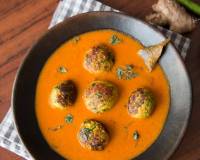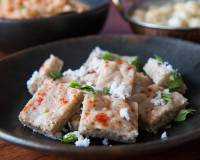Traditional Bengali Rasgulla Recipe - Cottage Cheese Balls In Sweetened Syrup
Bengali rasgulla recipe is an excellent recipe for this regional classic from the state of West Bengal. These delicate cottage cheese dumplings are soaked in sugar syrup are absolutely delicious and perfect to serve after an indian meal.

Bengali rasgulla recipe is an excellent recipe for this regional classic from the state of West Bengal. Delicate cottage cheese dumplings, soaked in sugar syrup, they’re also called Rosogolla. The process has multiple steps, but yields a super soft rasgulla that is steamed and then soaked in a flavoured sugar syrup.
I typically like to flavor the sugar syrup with a rose petals for a refreshing festive flavour, but you could also use saffron or cardamom depending on your preference. Rasgulla may be served on festivals like Navratri or Diwali, but are equally wonderful when served at the end of an Indian thali meal for friends and family.
Some other popular Bengali sweets are:
15 M
60 M
75 M
8-10 Servings
Ingredients
- 6 cups Milk
- 3 tablespoons Lemon juice
- 2 tablespoons Curd (Dahi / Yogurt)
- 2 cups Sugar
- 4-1/2 cups Water
- 1/4 teaspoon Cardamom Powder (Elaichi)
- 1 Cloves (Laung)
How to make Traditional Bengali Rasgulla Recipe - Cottage Cheese Balls In Sweetened Syrup
To begin making the Bengali Rasgulla, first mix curd and lemon juice together in a bowl. Bring the milk to a roaring boil; when it starts to foam and rise, reduce the flame to medium and add curd-lemon juice mix and give it a stir. The milk will begin to curdle and get separated from the whey. When all the milk is curdled and only a clear whey remains, turn off the heat.
The curdled milk is the cottage cheese, allow the milk to rest in the whey water for a few minutes. Spread a muslin cloth/cheese cloth (Make sure its big enough to get tied up) and drain the curdled milk.
Now bring the edges of the cloth together and immerse it (up and down process) in a bowl filled with ice cubes and cold water. Slightly rub the bag so that it releases the lemon juice flavor and bring the curdled milk together to a ball. Squeeze water well and tie the bag.
Now on a flat plate, first place the sack, then a tawa or plate and finally some heavy weight. This helps to squeeze all excess water. Let it sit for 1 hour without any disturbance, until you see a lot of whey is released.
Remove the paneer from the muslin cloth and place it on a flat surface. Scramble and knead using your palm for 10 minutes. You can feel the paneer getting soft. Make them to equal-sized balls by rolling in your hand, making sure there are no cracks on the ball surface.
In a pressure cooker (wide enough) boil sugar and water. When bubbles starts to form, add Cardamom powder, clove and paneer balls (one by one) slowly. Cover the cooker and pressure cook for 1 whistle.
After a whistle, reduce the flame to low and let it simmer for another 5 minutes. Turn off the heat and allow the pressure come down.
Once the pressure is completely released, open the cooker. You will notice the Rosogolla are doubled in their size. Replace the rasgullas carefully to another bowl, cool down completely. Refrigerate for 2 hours minimum before serving.
Notes
Wash the paneer well to avoid lemon taste in rasgullas.
Squeeze the maximum to drain the water and then place a weight.
You can use the whey water for making chapati batter.
Kneading the dough is a very important step to get the rasgullas soft.
My friend's mother suggested to add a teaspoon of maida and stir after kneading the paneer. This helps rasgullas to be a bit firm and withstands its round shape.
If you feel the paneer is very much drained or is not binding while making balls, then drizzle some drops of water alone and knead again.
Please make sure to use a wide cooker or pan as rasgulla expand after cooking.
Do replace rasgullas to another bowl after cooking to avoid overheating.
We can also prepare them in a large pan by simply closing them for 10 to 15 minutes after paneer balls are added.
When rasgullas are cooked they are extremely soft but will get firm after refrigerating.







